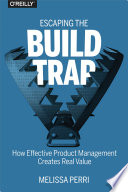

The Build Trap is a critical concept introduced by Melissa Perri, which refers to the situation where organizations focus solely on delivering features and outputs rather than achieving meaningful outcomes. In this state, companies often find themselves stuck in a cycle of building products without understanding the real needs of their users or the market. This leads to wasted resources and missed opportunities for innovation. Perri emphasizes that teams must shift their focus from just building to understanding the 'why' behind their products. This involves engaging with users, gathering feedback, and iterating based on real-world insights. By recognizing the Build Trap, organizations can begin to realign their strategies to focus on delivering value, ensuring that their efforts lead to meaningful impacts rather than just outputs.
Continue readingOne of the central themes of the book is the distinction between outcomes and outputs. Outputs are the features, functionalities, and products that a team delivers, while outcomes are the results of those outputs in terms of user satisfaction, business impact, and overall value. Perri argues that organizations need to prioritize outcomes to drive success. This means establishing clear metrics and goals that reflect the desired impact of their products, rather than simply counting the number of features released. By focusing on outcomes, teams can ensure that their work aligns with user needs and business objectives, leading to greater satisfaction and success in the marketplace.
Continue readingPerri discusses the significance of fostering a product culture within organizations. A product culture is characterized by a shared understanding of product goals, collaboration across teams, and a commitment to user-centric design. This culture encourages teams to take ownership of their products and continuously seek feedback from users. In a strong product culture, everyone from executives to individual contributors understands the importance of aligning product development with user needs and business outcomes. Perri provides strategies for cultivating this culture, such as promoting cross-functional collaboration, encouraging experimentation, and celebrating learning from failures. By building a product culture, organizations can empower their teams to innovate and deliver products that truly resonate with users.
Continue readingProduct management plays a crucial role in escaping the Build Trap. Perri outlines the responsibilities of product managers in guiding teams towards a focus on outcomes. This includes conducting user research, defining product vision and strategy, and ensuring alignment between stakeholders. Effective product managers act as the bridge between technical teams and business objectives, helping to clarify priorities and make informed decisions. Perri emphasizes that product managers should not only be seen as project managers but as leaders who drive product strategy and foster a user-centric approach. By strengthening the role of product management, organizations can enhance their ability to deliver impactful products.
Continue readingThe book advocates for the adoption of Lean and Agile methodologies as tools to escape the Build Trap. These practices promote iterative development, continuous feedback, and a focus on delivering value to users. Perri explains how Lean principles can help teams eliminate waste by identifying what truly matters to users and concentrating their efforts on those areas. Agile methodologies support flexibility and responsiveness, allowing teams to adapt to changing user needs and market conditions. By integrating these practices into their product development processes, organizations can become more efficient and effective in delivering products that meet user expectations.
Continue readingPerri emphasizes the need for a structured product strategy framework to guide teams in their decision-making processes. This framework should include defining a clear product vision, setting measurable goals, and outlining key initiatives that align with both user needs and business objectives. By having a structured approach, teams can better prioritize their work and ensure that they are focusing on high-impact initiatives. Perri provides practical tools and techniques for developing a product strategy, such as the use of roadmaps, impact mapping, and user story mapping. This structured approach helps organizations avoid the pitfalls of the Build Trap and stay aligned with their desired outcomes.
Continue readingFinally, Perri stresses the importance of continuous learning and adaptation in product development. The market and user needs are constantly evolving, and organizations must be willing to learn from their experiences and adapt their strategies accordingly. This involves fostering a mindset of experimentation, where teams are encouraged to test hypotheses, gather data, and iterate based on feedback. Perri suggests implementing regular retrospectives and reviews to reflect on what is working and what isn’t, allowing teams to make informed adjustments to their processes and products. By embracing a culture of continuous learning, organizations can remain agile and responsive, ultimately leading to more successful product outcomes.
Continue reading